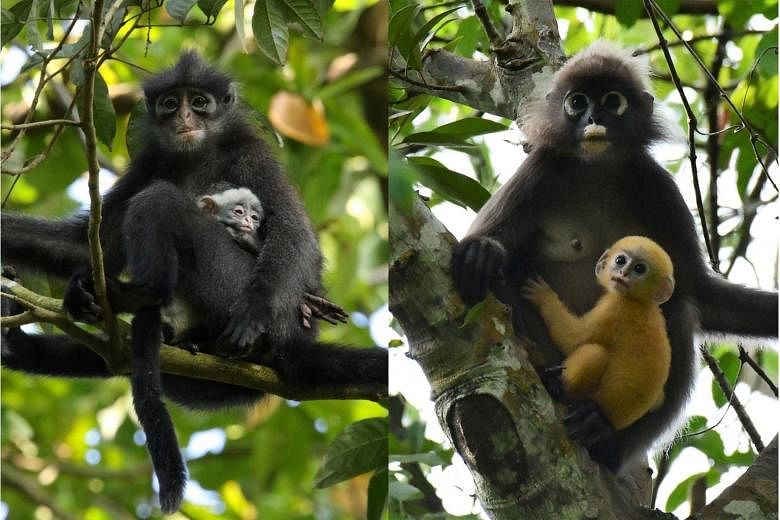There is a new monkey species in town, and scientists here are assessing how its presence could affect Singapore's two native monkey species.
Three dusky langurs (Trachypithecus obscurus), a species native to Malaysia but not Singapore, were first seen in Woodlands last August.
By December, two of them had made their way to Thomson Nature Park where they remained until January this year, noted the Singapore researchers in a paper published last month in the Journal of Threatened Taxa.
The third individual was not seen after Sept 1 last year, and could have died or left the group, said primate researcher Andie Ang, the paper's lead author.
By March, just before the start of the circuit breaker period when biodiversity surveys could not be conducted, the researchers found that the two remaining individuals, both male, had ventured farther south to Windsor Nature Park.
Dr Ang, a Wildlife Reserves Singapore (WRS) Conservation Fund research scientist, said the langurs appeared healthy and wild, and this indicated that they could have swum across the narrow Johor Strait or entered Singapore via the Causeway.
Numerous encounters between the dusky langurs and Singapore's two native monkey species have been documented since.
For example, in one encounter on Jan 18, the dusky langurs were chased from a tree by a long-tailed macaque, one of the Republic's native species that is commonly sighted.
The dusky langurs were separately seen chasing 11 Raffles' banded langurs - a shy, critically endangered species found only in Singapore and southern Peninsular Malaysia - from a tree where they were feeding.
Dr Ang said the two dusky langurs were likely still around, and added that further monitoring will be required to assess their impact on local primates.
She told The Straits Times: "We need to monitor the interactions between the duskies and native primates, to assess if they may displace banded langurs and macaques from their feeding or sleeping sites such that their original home ranges may be altered."
The long-tailed macaque has brown fur, which differs from the black-and-white coat of both langur species.
But even though they look alike, the dusky langurs and the Raffles' banded langurs have distinct differences in their appearance.
For example, the white eye rings and white markings around the mouths of dusky langurs are more prominent than on the Raffles' banded langurs, said Dr Ang.
Dusky langurs are also bigger, and have babies which are born with orange fur - compared with the white-furred young of the Raffles' banded langur, said Dr Ang.
Another author of the study, Mr Max Khoo, manager of wildlife management research at the National Parks Board (NParks), said the dusky langur and the Raffles' banded langur can both be found in the same forest habitats in Malaysia, where both species are able to co-exist.
"It is unlikely that the presence of dusky langurs in Singapore might pose any significant long-term ecological impact to our Raffles' banded langur population," he said.
However, NParks will continue to work with the Raffles' banded langur working group - which Dr Ang chairs - to monitor the dusky langurs to assess their potential ecological impact, he said.
Mr Khoo said the dusky langur is generally shy and not likely to approach humans.
He said: "This particular group of dusky langurs has been observed to flee from humans when approached.
"Should members of the public spot them, keep a distance, do not try to feed them, and please call the NParks Animal Response Centre on 1800-476-1600 to report the sighting."
Dr Sonja Luz, WRS director of conservation, research and veterinary services, said: "As a core advocate for primate research, the WRS Conservation Fund applauds the efforts of our research scientists and the government agency who are studying the dusky langurs to better understand their ecological role and impact on existing wildlife in Singapore."


